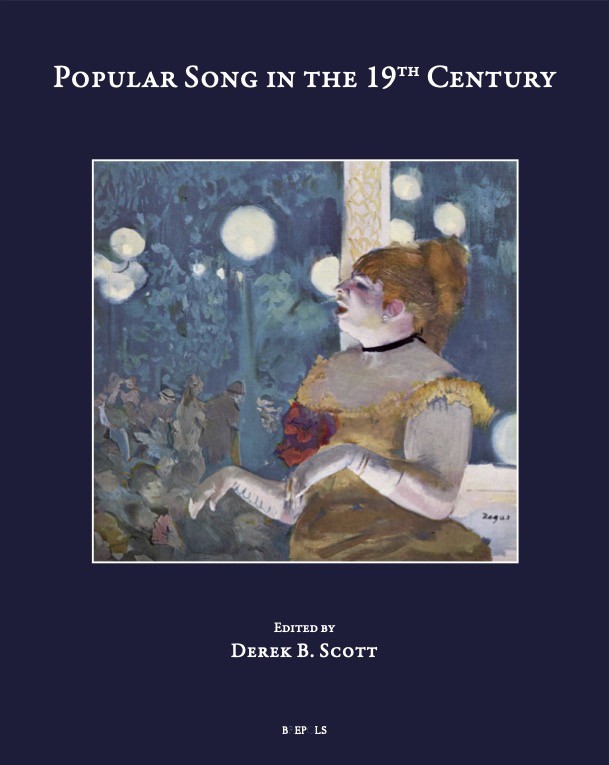Popular Song in the 19th Century
 Livre collectif en anglais sous la direction de Derek B. Scott. Turnhout : Brepols, 2022. Avec le soutien du Palazzetto Bru Zane.
Livre collectif en anglais sous la direction de Derek B. Scott. Turnhout : Brepols, 2022. Avec le soutien du Palazzetto Bru Zane.
De nombreux types de chansons populaires nouvelles et passionnantes ont vu le jour au XIXe siècle, et les auteurs de ce volume placent le développement et la réception de ces chansons dans un contexte social et culturel. Les chapitres sont regroupés en quatre parties.
La première partie étudie les passages de frontières : une chanson de gondolier connue dans le monde entier, les chansons populaires dans le sud des États-Unis, l’impact de la musique américaine en Allemagne et la musique brésilienne en Europe. La deuxième partie se concentre sur les espaces publics et privés : les cabarets de Montmartre, les salons de Berlin et de Prague, les chansons populaires et l’orgue d’église, les chansons de théâtre au Portugal et en Espagne. La troisième partie aborde le thème de la lutte sociale : les chansons de protestation allemandes, les chansons tchèques et les chansons populaires américaines de l’Antebellum. La quatrième partie est consacrée aux questions d’identité culturelle : chansons des Flandres, chansons de la culture irlandaise des années 1890, chansons de l’« esprit slave » russe, chansons urbaines en Grèce après la guerre d’indépendance (1821), et chansons rurales et urbaines serbes.
Table des matières
Derek B. Scott – Introduction: The New Popular Songs of the Nineteenth Century
Part I: Cultural Transfer
Henrike Rost – ‘La Biondina in Gondoletta’: The Transnational Success Story of a Popular Gondola Song
Chloe Valenti – Between Opera and Popular Song: The Transformation of ‘Va pensiero’ in Victorian Britain
Candace Bailey – Opera, Lieder, or Stephen Foster? Popular Song in the Antebellum US South
Tobias Fasshauer – «Wenn das Banjo zittert»: Americanism in Popular Songs of the Wilhelmine Era
Flávia Camargo Toni – The Twenty modinhas for Voice and Piano by Sigismund Neukomm and Joaquim Manoel Gago da Câmara: A ‘Transatlantic’ Partnership
Part II: Private and Public Spaces
Michela Niccolai – Montmartre in Its Songs: Between Café-concert and Cabaret (c. 1860-1914)
Anja Bunzel – Popular Song in the (Semi-)Private Domain? Considering the Nineteenth-Century Salon within the Context of Popular Culture
Eva-Maria de Oliveira Pinto – Popular Songs in the Ecclesiastical Context: Discoveries in European and North American Organ Music of the 19th Century
Catarina Ribeiro Braga – The Portuguese Chansonnette at the End of the Nineteenth Century: The New Popular Song or a Mini-comic Scene?
María Encina Cortizo & Ramón Sobrino – Popular Dance Songs in the 19th Century beyond the Spanish Borders: La cachucha and Las habas verdes
Part III: Social Struggle
David Robb – Popular Protest Songs of the German Vormärz and 1848 Revolution
Viktor Velek – Master Jan Hus and Hussitism as the Subject of Czech Social Songs in the First Half of the 19th Century
Wojciech Bernatowicz – «He’s Gone to Be a Soldier in the Army of the Lord»: Politics in the Antebellum American Popular Song
Part IV: Cultural Identity
Jan Dewilde – «I Know a Song»: Two Popular Flemish Songs about Singing a Song
Áine Mulvey – Dialect Verse and Songwriting during the Irish Cultural Revival (1891-1922)
Mirella Di Vita – Pesnja e Romans: The Forms of the Russian Art Song at the Beginning of the 19th Century
Avra Xepapadakou – Popular Song in 19th-Century Greece
Marijana Kokanović Marković – Serbian Popular Song in the 19th-Century: Their Cultural and Social Role
Permalien
date de publication : 19/10/23

